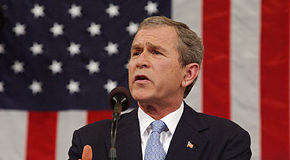
A Too Powerful President?
Formal and Informal Powers
By Bryan Ashkettle
For better or worse, the power within the office of the president has been steadily increasing in the modern era. This puts U.S. civics and government teachers in a bit of a bind trying to square the true intent of the Constitution regarding presidential power with the reality of the president’s power in its current form. Alexander Hamilton’s Federalist Paper No.70 clearly advocates for such an expansion to assure “energy” and action for the chief executive. But perhaps Hamilton himself would be appalled at the amount of power modern presidents have garnered for themselves through formal and informal action.
This controversy regarding a president’s power affords students the opportunity to critically think and debate on actual historical and modern examples. Below is my lesson to allow students to practice this skill. This lesson would be most effective after teaching the students the formal and informal powers of the president as well as Federalist Paper No. 70. I always like utilizing a 3-corners exercise as it gets the students up, moving, discussing, and then debating important positions.
Lesson Plan
Lesson Objective: To determine whether modern presidents’ expansion of informal powers exceed the intention of the Constitution.
Step 1 – Label 3 corners in your classroom.
Corner 1 – “Presidential Power is justified in the Constitution (Formal Power)”
Corner 2 – “Presidential Power is justified although not in the Constitution (Informal Power)”
Corner 3 – “Presidential Power is not justified either formally or informally”
Step 2 – Give students Example 1 from the historical or contemporary examples below. (Repeat the procedure with examples 2, 3, 4, and 5).
Example 1 – Former President Trump in August of 2022 claimed the power to take top-secret documents to his home through the act of declassification and executive privilege. Therefore, President Trump and his attorneys believe that the search done to is home in Mar-a-Lago on August 8, 2022 by the Justice Department was unlawful. Is such presidential power justified?
Example 2 – Presidents Kennedy, Johnson, and Nixon, 1950 through 1970s, used their military powers as commander in chief to commit troops in Vietnam without a congressional declaration of war. Was such presidential power justified?
Example 3 – President Obama in 2016 created an executive order relying on Title IX, which protects people from discrimination based on sex in education, to allow transgender students to use the bathroom of their choice. Was such presidential power justified?
Example 4 – President Biden in August of 2022 created an executive order that directed the Secretary of Health and Human Services to assure that medication to terminate pregnancy is widely available as possible. This was done after Dobbs v. Jackson 2022 which allowed states to disregard Roe v. Wade 1973 and make abortion illegal if they wish. Is such presidential power justified?
Example 5 – President Franklin Roosevelt issued executive order 9066 in 1942 authorizing the evacuation of all persons deemed a threat to national security from the West Coast to relocation centers further inland. Over 100,000 Japanese-Americans, many U.S. citizens, were confined in internment camps. FDR’s action was ruled constitutional in the case of Korematsu v. United States 1944. Was such presidential power justified?
Step 3
The teacher can read aloud each of the examples (one per round of the exercise), allowing for the students to quickly ask for clarification.
The students then go to the corner of their choice.
While there, students should deliberate on reasons that justify their positions. (5 Minutes)
Students should then choose a student in their corner to share out their argument for their position.
After all 3 corners provide their rationales, allow for the students to challenge, in a respectful way, the positions of the other two groups. (5 – 10 Minutes)
Once one example is done, have the students return to their seats and read the next example of presidential action and repeat the procedure.
Explanation
Please note, although the main goal of this lesson is to have the students practice argumentation through critical thought, there are some correct answers. After the students have expressed their reasoning in their groups/corners, teachers should remind them that actions such as executive orders, agreements, executive privilege, and using the media are largely considered informal powers. Whereas, defending the U.S., signing bills into law, and appointing administrators are formal powers. However, I also encourage the students to argue against the Framers intentions and to make the case that certain formal and informal powers should have never existed in the first place, regardless of what the Constitution, political tradition, or the Supreme Court says.
For Advanced Placement Government teachers, the learning objective for lesson 2.6, reads, “Explain how presidents have interpreted and justified their use of formal and informal powers.” This objective would go excellently with an Argumentative FRQ #4 prompt. This lesson could be used when teaching Unit 2, Interactions of the Branches of Government within the CED.
Practice 5 of the Course and Exam Description asks the students to articulate a defensible claim/thesis. This lesson allows for the students to do this verbally in a safe setting. These types of arguments allow the students to be introduced to historical or current events that are related to the essential knowledge within the CED. Furthermore, this lesson will allow the students to demonstrate their skill of argumentation and reasoning that will prepare them to write FRQ #4 in a way that is grounded in the Constitution and the foundational documents.
Dr. Bryan Ashkettle is an AP US Government Teacher at Solon High School in Northeast Ohio, an APSI Consultant for the College Board, and an educational consultant for Ursuline College in Pepper Pike, Ohio. He resides in Chagrin Falls with wife Stefanie (also a teacher), daughter Julia, daughter Frankie, and niece Jayla. He is (sadly), a Cleveland sports fan.
